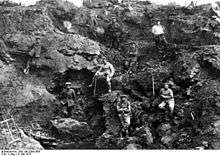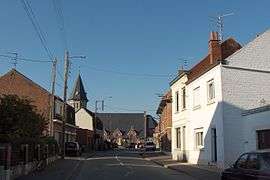Fromelles
| Fromelles | ||
|---|---|---|
|
Village of Fromelles | ||
| ||
 Fromelles | ||
|
Location within Hauts-de-France region  Fromelles | ||
| Coordinates: 50°36′25″N 2°51′21″E / 50.6069°N 2.8558°ECoordinates: 50°36′25″N 2°51′21″E / 50.6069°N 2.8558°E | ||
| Country | France | |
| Region | Hauts-de-France | |
| Department | Nord | |
| Arrondissement | Lille | |
| Canton | La Bassée | |
| Intercommunality | Weppes | |
| Government | ||
| • Mayor (2008–2014) | Hubert Huchette | |
| Area1 | 8.54 km2 (3.30 sq mi) | |
| Population (1999)2 | 961 | |
| • Density | 110/km2 (290/sq mi) | |
| Time zone | CET (UTC+1) | |
| • Summer (DST) | CEST (UTC+2) | |
| INSEE/Postal code | 59257 / 59249 | |
| Elevation |
18–32 m (59–105 ft) (avg. 85 m or 279 ft) | |
|
1 French Land Register data, which excludes lakes, ponds, glaciers > 1 km² (0.386 sq mi or 247 acres) and river estuaries. 2 Population without double counting: residents of multiple communes (e.g., students and military personnel) only counted once. | ||
Fromelles (pronounced: [fʁɔmɛl]) is a commune in the Nord department in northern France. In 2004 it had a population of 907; its inhabitants are called Fromellois. It is located about 16 kilometres (9.9 mi) to the west of Lille.
First World War
The village of Fromelles was captured by advancing German forces on 9 October 1914 during the "Race to the Sea". Throughout almost the whole of the war, the front line was stable, running through the territory of the commune and leaving the inhabited area in German hands. The Battle of Aubers Ridge was fought in the area to the northwest of the village on 9 May 1915 as part of the Second Battle of Artois.
Battle of Fromelles

The Battle of Fromelles on 19–20 July 1916 was the first occasion on which the First Australian Imperial Force (AIF) saw action on the Western Front. The battle is widely regarded as a disaster for the Allies, and has been described as "the worst 24 hours in Australia's entire history."[1] It resulted from a plan to divert German attention from the Battle of the Somme, but historians estimate that 5,500 Australians and 2,000 British troops were killed or wounded. The Australian losses were equivalent to the combined total Australian losses in the Boer War, Korean War and Vietnam War:[1] although later World War I actions would be more deadly for the AIF, Fromelles was the only one to achieve no success.[2]
Adolf Hitler is believed to have served as a messenger on the German side with the 6th Bavarian Reserve Division.[3]
Cemeteries
Four hundred unidentified bodies retrieved from the battlefield by the Allies are buried in the V.C. Corner Australian Cemetery and Memorial, about two kilometres from Fromelles.[2][4] There are no headstones in the cemetery, two large concrete crosses marking where the 400 soldiers are buried.
Many bodies of Allied soldiers were retrieved by the German forces and buried behind German lines. Most of these were located after the war, but 399 bodies remained unaccounted for, despite the certainty of their death (the soldiers' names and personal belongings had been passed to their families via the Red Cross).[5] In July 2007, archaeologists from Glasgow University, relying on information provided by an amateur Australian historian, Lambis Englezos, opened the largest mass grave of allied soldiers discovered since the end of the Great War in a field on the outskirts of Fromelles.[5] Excavation of the mass graves was carried out May–September 2009, and the remains of 250 British and Australian soldiers recovered.[6] The bodies were reburied in the new Fromelles (Pheasant Wood) Military Cemetery, about 120 metres from the site of the original mass grave.[7]
During the four years of the Great War, British division after division fought in that area of the Western Front which we now know as Fromelles and which forms part of what is now referred to as “The Forgotten Front”. Prior to the discovery of the mass graves at Pheasant Wood, Fromelles was known only for being the place where the Australian Imperial Force had experienced its first, and disastrous, taste of action on the Western Front. Whilst Fromelles hosts both the CWGC memorial to the AIF at VC Corner and the Australian Memorial Park, with the exception of a small private memorial to an officer of the Rifle Brigade, no memorial to the British casualties exists in this area. British losses were numbered in their many thousands in and along this line, but the majority of the men killed in action in this area between 1914 and 1918 are commemorated on the Ploegsteert Memorial to the Missing in Belgium. A charitable association, known as the British Memorial Association, Fromelles, has been set up to establish a memorial in Fromelles, dedicated to the thousands of British men who gave their lives in this small corner of France, by educating people about the magnificent efforts of the British Army in this area of the ‘Forgotten Front’, the Association will endeavour to redress this balance and should be the first port of call for anyone, regardless of nationality, who is interested in Aubers Ridge and Fromelles throughout the Great War.[8]
See also
References
- 1 2 McMullin, Ross (2006), "Disaster at Fromelles", Wartime (Issue 36).
- 1 2 V.C. Corner Australian Cemetery and Memorial, Commonwealth War Graves Commission, retrieved 31 January 2010.
- ↑ Putting names to the lost soldiers of Fromelles, BBC News, 29 January 2010.
- ↑ "Something of the horrors of war – VC Corner Australian Cemetery and Memorial", Australians on the Western Front 1914–1918, Australian Department of Veteran's Affairs, retrieved 31 January 2010.
- 1 2 Copping, Jasper (22 July 2007), "Mystery of Great War's lost army uncovered", Sunday Telegraph, London, retrieved 3 May 2010.
- ↑ Fromelles grave excavation ends, BBC News, 10 September 2009.
- ↑ WWI war dead reburied in special service, BBC News, 30 January 2010.
- ↑ The British Memorial Association, Fromelles, Jeremy Banning, 12 October 2010.
External links
| Wikimedia Commons has media related to Fromelles. |
- Video of VC Corner and Australian Memorial Park, Fromelles. Jason Fielding
- Fromelles (Pheasant Wood) Military Cemetery nears completion video report from the Commonwealth War Graves Commission
- The Fromelles Website

_Nord-France.svg.png)